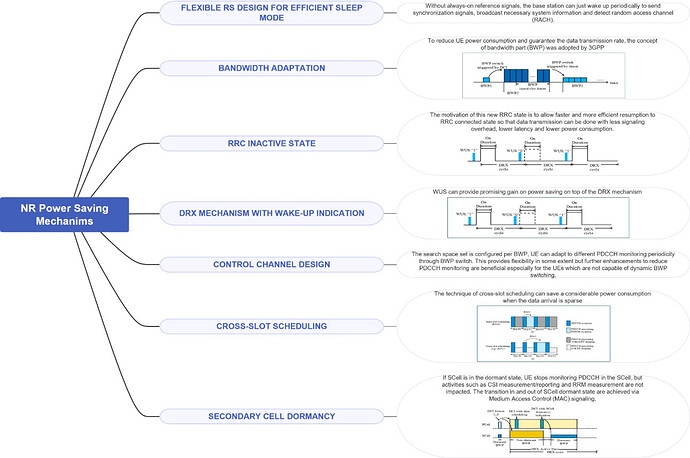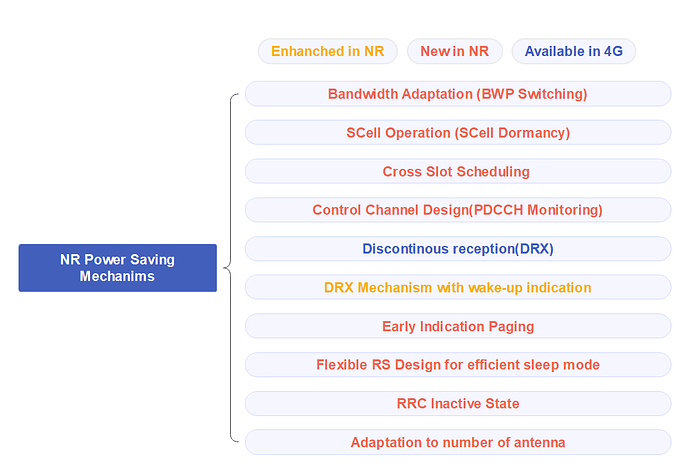The below picture summarizes the 𝗣𝗼𝘄𝗲𝗿 𝗦𝗮𝘃𝗶𝗻𝗴 𝗠𝗲𝗰𝗵𝗮𝗻𝗶𝘀𝗺 𝗽𝗿𝗼𝘃𝗶𝗱𝗲𝗱 𝗶𝗻 𝟱𝗚.
-
Energy efficiency is 𝗼𝗻𝗲 𝗼𝗳 𝘁𝗵𝗲 𝗸𝗲𝘆 𝗽𝗲𝗿𝗳𝗼𝗿𝗺𝗮𝗻𝗰𝗲 𝗶𝗻𝗱𝗶𝗰𝗮𝘁𝗼𝗿𝘀 in 5G New Radio (NR) networks targeted to support diversified use cases including enhanced mobile broadband (eMBB), massive machine type communications (mMTC) and ultra-reliable and low latency communications (URLLC).
-
Energy efficiency is important for both user equipment (UE) side and base station side. On UE side, 𝗨𝗘 𝗯𝗮𝘁𝘁𝗲𝗿𝘆 𝗹𝗶𝗳𝗲 𝗵𝗮𝘀 𝗴𝗿𝗲𝗮𝘁 𝗶𝗺𝗽𝗮𝗰𝘁 𝗼𝗻 𝘂𝘀𝗲𝗿 𝗲𝘅𝗽𝗲𝗿𝗶𝗲𝗻𝗰𝗲. It is challenging to improve UE experience in other performance aspects without affecting battery life of 5G handsets.
-
Some essential components for building 𝗮 𝘀𝘁𝗮𝗻𝗱𝗮𝗿𝗱𝗶𝘇𝗲𝗱 𝗳𝗿𝗮𝗺𝗲𝘄𝗼𝗿𝗸 𝗼𝗳 𝗲𝗻𝗲𝗿𝗴𝘆 𝗲𝗳𝗳𝗶𝗰𝗶𝗲𝗻𝘁 𝟱𝗚 𝘀𝘆𝘀𝘁𝗲𝗺 𝗮𝗿𝗲 𝗽𝗿𝗼𝘃𝗶𝗱𝗲𝗱. These components include flexible reference signal design, efficient sleep modes, bandwidth adaptation, RRC inactive state, DRX mechanism, control channel design and cross-slot scheduling. Some of the description is more from UE power saving perspective. Below are some of the techniques that can be used for power saving from network perspective in combination with flexible and scalable framework.
(1) FLEXIBLE RS DESIGN FOR EFFICIENT SLEEP MODE
(2) BANDWIDTH ADAPTATION
(3) RRC INACTIVE STATE
(4) DRX MECHANISM WITH WAKE-UP INDICATION
(5) CONTROL CHANNEL DESIGN
(6) CROSS-SLOT SCHEDULING
(7) SECONDARY CELL DORMANCY
𝗥𝗲𝗳𝗲𝗿 𝘁𝗼 𝘁𝗵𝗲 𝗯𝗲𝗹𝗼𝘄 𝗿𝗲𝗳𝗲𝗿𝗲𝗻𝗰𝗲𝘀 𝗳𝗼𝗿 𝗺𝗼𝗿𝗲 𝗶𝗻𝘁𝗲𝗿𝗲𝘀𝘁𝗶𝗻𝗴 𝗱𝗲𝘁𝗮𝗶𝗹𝘀:
-
Power Saving Techniques for 5G and Beyond in IEEE.
-
NR next generation Book - Page 316 to 320
LinkedIn: ![]()

